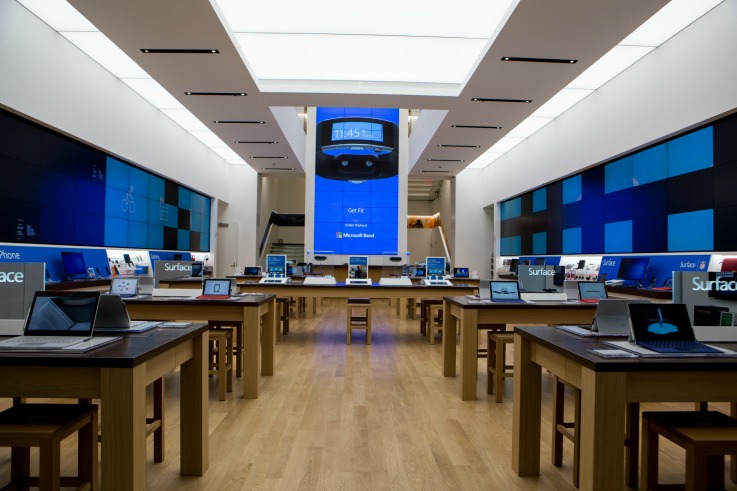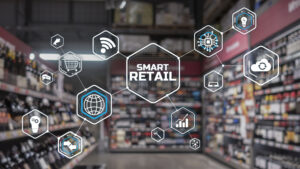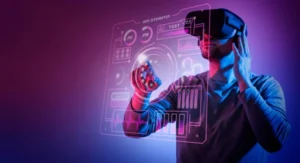The Evolution of Tech Stores: From Brick-and-Mortar to Digital Domains

The landscape of technology retail has undergone a profound transformation, with a shift from traditional brick-and-mortar establishments to the expansive realms of the digital domain. This evolution has not only revolutionized the way consumers interact with tech products but has also reshaped the business strategies employed by retailers. In this article, we will delve into the multifaceted journey of tech stores, exploring the key milestones, challenges, and innovations that have defined this remarkable transition.
The Rise of Brick-and-Mortar Tech Stores

In the early days of technology retail, brick-and-mortar stores stood as the primary hub for enthusiasts and consumers alike. These physical spaces served as more than mere retail outlets; they were experiential zones where customers could touch, feel, and interact with the latest gadgets. The atmosphere was vibrant, with knowledgeable staff providing personalized assistance, fostering a sense of community among tech enthusiasts.
As technology advanced, these physical stores became showcases for innovation. From the advent of personal computers to the proliferation of smartphones, brick-and-mortar tech stores played a pivotal role in introducing cutting-edge products to the public. The excitement of unboxing a new device, and the tactile experience of trying out different features – were integral aspects of the brick-and-mortar tech shopping experience.
The surge in foot traffic also paved the way for strategic partnerships and in-store promotions. Tech giants strategically positioned their products within these physical spaces, leveraging the visual and hands-on appeal to capture the attention of potential customers just like men’s t-shirts for sale are presented in front of the store so that the customers can see them immediately. However, as technology continued its relentless march forward, a new frontier emerged, prompting a paradigm shift in the retail landscape.
The Digital Revolution: Online Tech Stores Take Center Stage
With the advent of the internet, the dynamics of tech retail underwent a seismic shift. Online tech stores emerged, offering a virtual marketplace where consumers could browse, compare, and purchase tech products from the comfort of their homes. This digital transition not only broadened the accessibility of tech products but also introduced a level of convenience that brick-and-mortar stores struggled to match. Digital tech stores always use custom branded packaging to send their products.
The digital realm allowed for an unprecedented range of products to be showcased, transcending the physical limitations of traditional stores. Consumers could explore an extensive catalog of gadgets, read reviews, and make informed decisions with just a few clicks. The convenience of doorstep delivery coupled with a diverse array of payment options made online tech stores increasingly attractive to a global audience.
As e-commerce platforms evolved, the concept of the “tech store” expanded beyond individual websites to encompass online marketplaces. Here, multiple vendors converged, creating a virtual mall of tech products. This competitive landscape fostered price wars and innovation, pushing tech companies to continually enhance their products and customer experiences.
There are a lot of good tech stores in Atlanta and you can visit them by renting a vehicle from Limousine Service Company in Atlanta.
Challenges and Adaptations in the Digital Age
While the digital transition brought immense advantages, it also posed challenges for both retailers and consumers. The absence of physical interaction meant that consumers could no longer test products before purchase, relying solely on online reviews and specifications. This shift necessitated a reimagining of customer service strategies, with live chats, virtual demos, and comprehensive product descriptions becoming essential components of online tech stores.
The digital domain also brought forth security concerns, with the rise of cyber threats and online scams. Tech stores had to invest heavily in secure online platforms, encryption technologies, and robust cybersecurity measures to instill confidence in their customer base. Additionally, the sheer volume of online transactions necessitated the development of efficient logistics and reliable delivery networks, further shaping the evolution of tech retail. To improve security many tech companies work with a company that provides security services in Los Angeles.
AI-Powered Personalization

One of the key advancements in tech retail is the utilization of AI to offer personalized shopping experiences. AI algorithms analyze customer preferences, purchase history, and browsing behavior to provide tailored product recommendations. This level of personalization goes beyond generic suggestions, ensuring that customers are presented with tech products that align with their specific interests and needs.
Imagine entering a virtual tech store where AI greets you by name, having learned your preferences from previous visits. The AI assistant guides you through a curated selection of products, highlighting features that match your preferences. This personalized approach not only enhances the customer experience but also increases the likelihood of discovering new and innovative tech solutions. AI also found its way to assist in long term care pharmacy services.
Immersive Shopping with Extended Reality (XR)
Extended Reality (XR), which includes virtual reality (VR), augmented reality (AR), and mixed reality (MR), is poised to redefine the way customers interact with tech products. XR technologies enable immersive shopping experiences, allowing customers to virtually explore and interact with products before making a purchase. VR is a great but exhausting experience and you should use IV hydration if you are playing VR games.
In the XR-enabled tech store of the future, customers can use VR headsets to step into a virtual showroom where products come to life. They can inspect the intricate details of a new smartphone, test the functionalities of a smart home device, or even simulate the experience of using a cutting-edge gaming console. This level of immersion enhances the decision-making process, providing customers with a more comprehensive understanding of the products they are interested in.
Sustainable Tech Retail
The evolution of tech stores is not only about technological advancements but also about addressing societal and environmental concerns. The future of tech retail involves a significant emphasis on sustainability and eco-conscious practices. Retailers are increasingly adopting eco-friendly packaging, promoting recycling initiatives, and sourcing products with minimal environmental impact. Things that also come in eco-friendly packaging are milk chocolate edibles. You can eat them while you are exploring tech stores on the internet.
Tech stores are becoming platforms for promoting sustainable tech solutions. From energy-efficient devices to products with recyclable materials, customers are presented with choices that align with their values. Sustainable tech retail is not only a response to growing environmental awareness but also a strategic move to appeal to a socially conscious consumer base. Tech stores often work with a branding company to reach more people.
Social Commerce and Community Engagement
The future tech store transcends the transactional aspect of retail and evolves into a social hub for tech enthusiasts. Social commerce, integrating e-commerce with social media platforms, becomes a pivotal aspect of the tech retail landscape. Customers can seamlessly share their tech discoveries, reviews, and experiences with their social networks, creating a community-driven approach to tech retail.
If you need a break from the tech world you can go to a luxury salon in Toronto to relax and regain energy.
Tech stores transform into interactive spaces where customers can participate in live product demonstrations, attend virtual events with industry experts, and engage in discussions about the latest technological trends. This sense of community fosters brand loyalty and turns the tech store into not just a place to buy products but a hub for tech enthusiasts to connect, share, and learn.
The Integration of Voice Commerce
As voice-controlled devices become increasingly prevalent in households, the integration of voice commerce into tech retail becomes a natural progression. Customers can use voice commands to search for products, place orders, and gather information about tech specifications. Voice assistants powered by AI facilitate a hands-free and seamless shopping experience.
In the future tech store, customers can interact with virtual assistants using natural language, asking questions about product features, or seeking advice on the best tech solutions for their needs. The integration of voice commerce not only enhances accessibility but also adds a layer of convenience, especially as smart speakers and voice-activated devices become ubiquitous.
Tech Stores as Experience Centers
Beyond the transactional nature of retail, tech stores of the future evolve into experience centers where customers can not only purchase products but also engage in hands-on experimentation. Interactive displays, workshops, and tech demos create an environment where customers can learn, explore, and be inspired by the possibilities of technology.
Imagine a tech store where customers can participate in coding workshops, test the latest virtual reality games, or experience live demonstrations of cutting-edge innovations. These experience centers not only attract customers seeking a more immersive encounter with technology but also position tech stores as educational hubs that empower individuals to embrace and understand the rapidly evolving tech landscape. In this kind of tech store, you can find the best headphones for college students.
Cybersecurity in Tech Retail: A Continuous Priority
As tech stores embrace digitalization and online transactions, the need for robust cybersecurity measures becomes paramount. The future of tech retail involves a continuous commitment to safeguarding customer data, ensuring secure payment gateways, and staying ahead of emerging cyber threats.
Tech stores invest in advanced encryption technologies, biometric authentication methods, and AI-driven threat detection systems to create a secure online shopping environment. Cybersecurity awareness becomes an integral part of the customer experience, assuring consumers that their personal and financial information is protected.
The Role of 5G in Tech Retail

The deployment of 5G technology is set to revolutionize the landscape of tech stores. With faster and more reliable connectivity, the possibilities for enhanced customer experiences multiply. In the 5G-powered tech store, customers can enjoy seamless augmented reality shopping, real-time product demonstrations, and high-quality virtual interactions. If you want to invest in 5G stores and you need a loan you can contact a company that has loan servicing software for private lenders.
The increased bandwidth and low latency of 5G open doors to innovations such as augmented reality navigation within physical stores, enabling customers to locate products effortlessly. The integration of 5G technology not only transforms the digital aspects of tech retail but also enhances the connectivity within brick-and-mortar stores, creating a more fluid and responsive shopping experience.
The Uncharted Territories of Quantum Computing in Tech Retail
Looking even further into the future, the advent of quantum computing introduces a paradigm shift in the capabilities of tech stores. Quantum computers, with their unparalleled processing power, have the potential to revolutionize inventory management, supply chain optimization, and personalized customer experiences. If you want to learn more about quantum computers there are a lot of online seminars hosted by the best virtual emcee.
In the quantum-powered tech store, retailers can analyze vast datasets in real-time, offering unprecedented insights into consumer behavior and market trends. Quantum computing also enhances the security of online transactions through the development of quantum-resistant encryption methods, ensuring that tech stores remain at the forefront of data protection.
Conclusion: A Dynamic Tapestry of Innovation
In conclusion, the evolution of tech stores transcends the dichotomy of physical and digital realms, weaving a dynamic tapestry of innovation that continually adapts to the changing landscape of technology. From AI-driven personalization and immersive XR experiences to sustainable practices and community-driven social commerce, the future of tech retail is characterized by diversity, interconnectedness, and a relentless pursuit of excellence.
If you want to open a tech store you can contact a construction expert witness to help you with legal stuff.
As we navigate this uncharted territory of technological advancement, one thing remains clear – the evolution of tech stores is an ongoing narrative, shaped by the collaborative efforts of tech enthusiasts, retailers, and innovators. Whether through the integration of voice commerce, the embrace of sustainability, or the transformative power of 5G and quantum computing, tech stores are poised to remain at the forefront of the ever-expanding frontier of technological possibilities.




